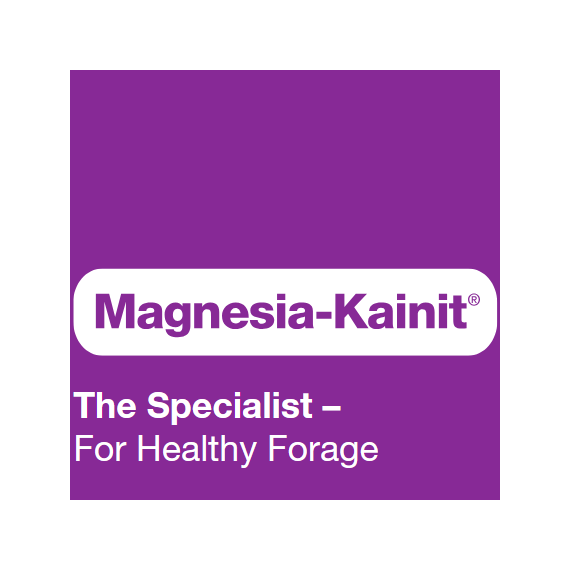
Magnesia-Kainit is with 9 % K2O a special fertiliser for grassland and forage cropping. This fertiliser is characterised by its magnesium and sulphur content (4 % MgO, 9 % SO₃) and sodium (35% Na2O) which is essential for animal feed. Magnesia-Kainit is an ideal supplementary fertiliser, if large amounts of liquid manure are applied.
EC FERTILISER
Kainit 9 (+4+35+9)
9 % K2O water-soluble potassium oxide
4 % MgO water-soluble magnesium oxide
35 % Na 2O water-soluble sodium oxide (= 26 % Na)
9 % SO₃ water-soluble sulphur trioxide (= 3.6 % S)
47 % Cl chloride
Magnesia-Kainit is a mined crude potash salt, containing the valuable mineral kieserite. All nutrients are water-soluble and are therefore immediately available to crops.
Magnesia-Kainit is effective regardless of the pH value of the soil and is therefore suitable for any location.
Magnesia-Kainit is a granulated fertiliser. Its particle size spectrum ensures a high spreading quality and enables constant distribution.
Magnesia-Kainit contains 9 % SO3 and thus contributes to an efficient utilisation of nitrogen fertilisation.
Magnesia-Kainit is certified for organic farming according to the regulations (EU) 2018/848 and (EC) No. 889/2008.
Magnesia-Kainit ® – For Improving Feed Quality
•The lack of magnesium in the feed ration can lead to the dreaded grass tetany and an unsatisfactory milk yield. The magnesium supply of plants and animals has to be ensured with the appropriate magnesium fertilisation with Magnesia-Kainit.
•Fertility problems lead to lack of appetite, weight loss and a decreasing milk yield. Symptoms are a shaggy hide and excessive licking. Regular fertilisation with Magnesia Kainit increases the magnesium and sodium content in the base feed and thus significantly contributes to the mineral supply of the animals.
• The administration of sodium-containing supplementary feed or the placement of animal lickstones alone does not ensure sufficient and regular sodium supply. Only a mineral supply stemming from the base feed can lead to the desired results.
• About 2 g Mg and 2 g Na per kg dry matter are necessary in the base feed to meet the daily magnesium and sodium requirements of dairy cows. According to analyses in the practice, the average magnesium and sodium content of grassland crops is about 1.3 to 1.5g Mg/kg dry matter and 0.1 to 1.0 g Na/kg dry matter. Accordingly they are insufficient.
• Experiments and observations have shown that animals grazing in differently fertilised areas always prefer the feed fertilised with Magnesia-Kainit; horses graze evenly.
• Sodium increases the palatability of the growth (forage, hay, silage), the animals consume more basic feed and are more productive. They eat more and have an improved mineral supply.
• A higher feed intake of cows leads to an additional milk yield of up to 2 l/day without the additional use of concentrates („Milk more milk from the basic feed!“)
• Sufficiently high magnesium and sodium contents are especially important for the first grassland growth, as they are generally very low. Fertilisation with Magnesia-Kainit prior to the first growth is therefore essential.
No reviews found
